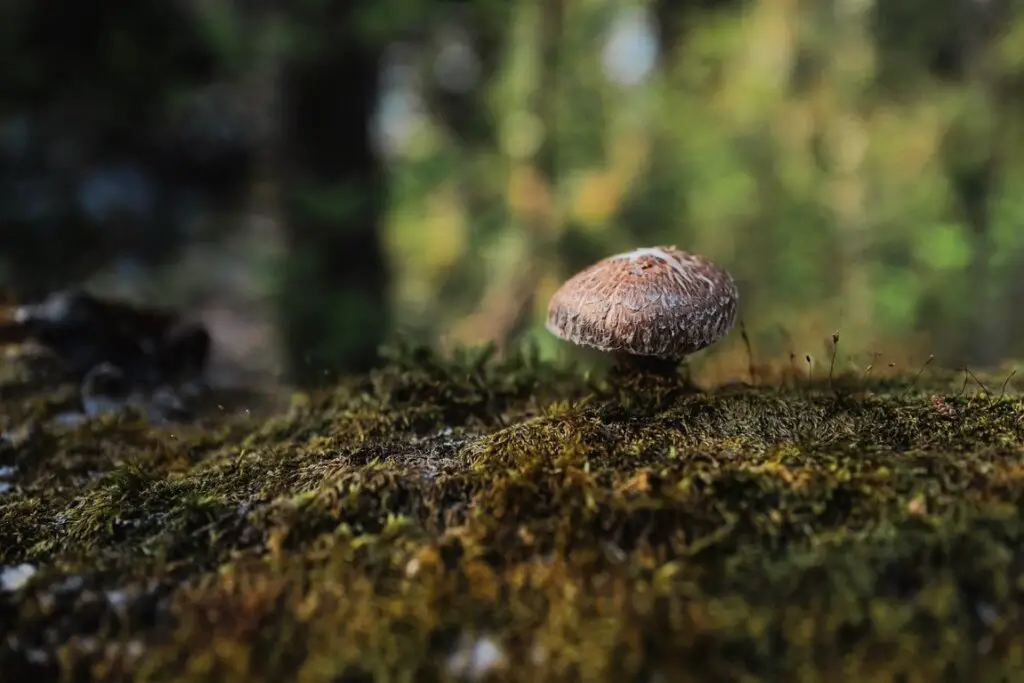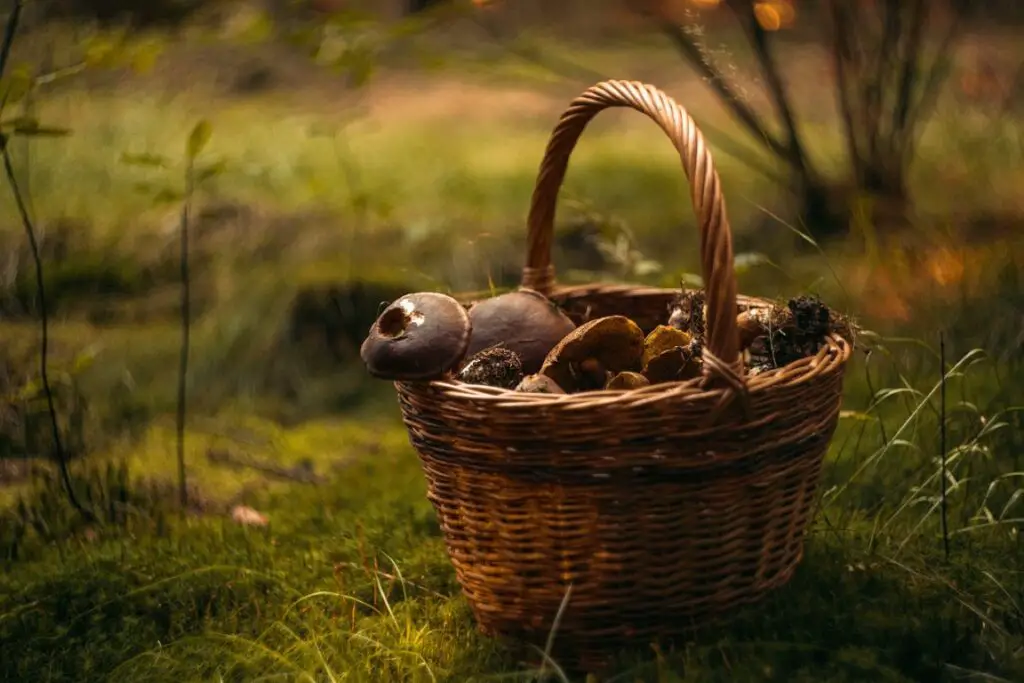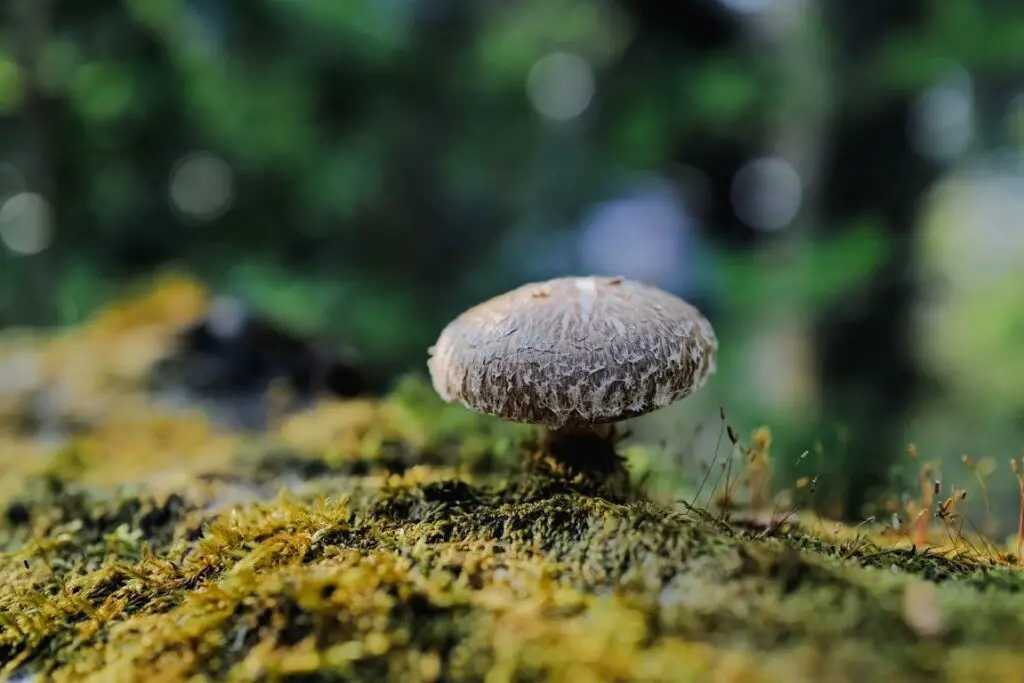To grow shiitake mushrooms (Lentinula edodes), you will need to start with shiitake mushroom spawn. You can then inoculate a substrate, such as hardwood logs or sawdust, with the spawn.
To inoculate a substrate take the following steps:
- Sanitize your workspace. Clean and disinfect your work area. This includes any tools or equipment that will come into contact with the substrate. This will help to prevent contamination from harmful bacteria or fungi.
- Prepare the substrate. Soak the substrate in water for 24 hours to hydrate it and make it more receptive to the mycelium. Drain the excess water and allow the substrate to air dry slightly.
- Prepare the spawn: Sterilize the syringe or watering can with the sterilizing solution. Fill the syringe or watering can with the shiitake mushroom spawn.
- Inoculate the substrate. Carefully inject the spawn into the substrate. Making sure to distribute it evenly throughout the mix. Aim for an inoculation rate of 2-3%, meaning you should use 2-3 grams of spawn per kilogram of substrate.
- Curing phase. Place the inoculated substrate in a dark, cool, and humid environment for 2-3 weeks. This allows the mycelium to colonize the substrate. The ideal temperature for this stage is between 55°F and 65°F. Maintain humidity levels around 80%.
- Fruiting phase. Once the mycelium has colonized the substrate. Transfer the container to a well-ventilated, humid environment with natural or artificial light. The ideal temperature for fruiting is between 60°F and 75°F. Maintain humidity levels at 80% or higher.
It is important to maintain the right level of moisture and temperature. This helps ensure a successful harvest.
What is the best wood to grow shitake mushrooms on
The best wood for growing shiitake mushrooms is hardwoods. Oak, beech, maple, and ironwood are most often chosen. These woods provide a suitable substrate for the shiitake mycelium to colonize and produce mushrooms.
Logs cut from healthy, living trees or freshly felled trees are usually preferred. They contain the necessary nutrients and moisture for successful mushroom cultivation. It’s important to use untreated wood. This avoids any potential contamination from chemicals or preservatives.
Best time to plant shiitake mushrooms
Shiitake mushrooms can be planted throughout the year. But the best time to start the cultivation process is typically Spring or fall, when temperatures are moderate.
But, with proper care and attention to environmental conditions. Shiitake mushroom cultivation can be successful at any time of the year.
Shiitake mushroom care:
Shiitake mushrooms are relatively easy to care for. But there are a few key things to keep in mind to ensure a successful harvest. Here are some tips for shiitake mushroom care:
Location and Temperature: Shiitake mushrooms prefer a warm, humid environment. The ideal temperature for growth is between 60°F and 70°F, with high humidity levels around 80%. If your grow room is too cold, the mushrooms may not grow properly. If it’s too humid, they may develop mold.
Light: Shiitake mushrooms do not need a high level of light to grow. In fact, they can actually thrive in low-light conditions. But, they will not grow in complete darkness. A moderate amount of indirect light is ideal.
Watering: Shiitake mushrooms need to be kept moist, but not soggy. The substrate should be damp but not dripping wet. Mist the substrate regularly to maintain moisture levels.
Fertilizer: Shiitake mushrooms do not need a lot of fertilizer to grow. In fact, excessive fertilization can actually harm the mushrooms. If you do choose to fertilize, use a balanced organic fertilizer and apply it sparingly.
Harvesting: Shiitake mushrooms are ready to harvest when their caps are fully expanded. And the undersides are golden brown. To harvest, simply twist the mushrooms off the substrate at the base. Avoid pulling them out. This can damage the mycelium , which is the root-like structure that supports the mushrooms.
, which is the root-like structure that supports the mushrooms.
Pests and Diseases: Shiitake mushrooms are relatively resistant to pests and diseases. But they can be affected by a few problems. One Most common problem is aphids, which can suck sap from the mushrooms and cause them to wilt. To control aphids, you can use insecticidal soap or neem oil. Another problem is fungi, such as Fusarium wilt and Trichoderma. To prevent these fungi, practice good sanitation and avoid overwatering.
Shiitake Mushroom Nutritional Benefits:
Shiitake mushrooms are a nutritional powerhouse, packed with vitamins, minerals, and antioxidants. Here are some of the key nutritional benefits of shiitake mushrooms:
High in Protein: Shiitake mushrooms are a good source of protein. Providing about 2 grams per 100 grams of mushrooms. This makes them a valuable addition to a vegetarian or vegan diet.
Rich in Vitamin D: These mushrooms are one of the few plant-based sources of vitamin D. This is essential for bone health and immune function.
One study found that consuming shiitake mushrooms regularly could increase vitamin D levels in the blood by up to 30%.
High in Fiber: Like Morel mushrooms Shiitake mushrooms are a good source of fiber. This can help to promote digestive health and regulate blood sugar levels. Fiber also helps to keep you feeling full, which can aid in weight management.
Rich in Antioxidants: They are a rich source of antioxidants, helping to protect cells from damage caused by free radicals. Free radicals are linked to aging and chronic diseases, such as cancer and heart disease.
Contain Ergothioneine: Shiitake mushrooms are one of the only foods that contain ergothioneine. This is an antioxidant that protects against oxidative stress and inflammation. Studies have linked ergothioneine to a reduced risk of developing age-related diseases.
May Boost Immune Function. They contain beta-glucans, which are compounds that boost the immune system. Beta-glucans can help to stimulate the production of white blood cells. which are responsible for fighting off infection.
May Improve Cholesterol Levels: Shiitake mushrooms contain eritadenine. This is a compound that has been shown to lower LDL (bad) cholesterol levels.
In addition to these specific nutrients. Shiitake mushrooms also contain a variety of other vitamins and minerals. including vitamin B2, vitamin B6, copper, potassium, and manganese.
Shiitake mushrooms are a nutritious and versatile food that can be enjoyed in a variety of ways. They are a good source of vitamins, minerals, and antioxidants. And they may have many health benefits.
This includes improved immune function, lower cholesterol levels, and reduced inflammation.
What do shiitake mushrooms taste like?
Shiitake mushrooms have a rich, earthy flavor with a hint of umami. They are often described as having a meaty texture. This makes them a popular ingredient in vegetarian and vegan dishes.
Here are some of the specific flavor notes that people often associate with shiitake mushrooms:
- Umami: Shiitake mushrooms are one of the best sources of umami. A savory flavor that is often described as having a meaty or brothy taste.
- Woody: Shiitake mushrooms have a slightly woody flavor. Best described as earthy or mushroomy.
- Slightly nutty: Some people also detect a light nutty flavor in shiitake mushrooms.
- Sweet: Shiitake mushrooms can also have a subtle sweetness, especially when cooked.
The flavor of shiitake mushrooms can vary depending on the variety. Growing conditions, and cooking method. For example. Fresh shiitake mushrooms tend to have a more delicate flavor than dried mushrooms.
Shiitake mushrooms that are cooked in butter or oil will have a richer flavor than those cooked in water.
Harvesting and storing shiitake mushrooms
When harvesting shiitake mushrooms, it’s best to pick them before the caps fully expand. This is typically when the caps are still slightly curled under. Use a sharp knife to cut the mushrooms at the base of the stem.
After harvesting, store the shiitake mushrooms in a paper bag or a container that allows for air circulation. They can be kept in the refrigerator for up to a week. If you have a large harvest, you can also consider drying the mushrooms for longer-term storage.
To do this, simply string them together and hang them in a well-ventilated area until they are completely dry. Dried shiitake mushrooms can be stored in an airtight container for several months.
The Last Word:
Picking mushrooms from the forest or ‘great outdoors’ is potentially hazardous to your health! DO NOT pick and eat any fungi that you are not 100% sure is safe to eat. If in doubt. Better to go along with someone who is familiar and knowledgeable with mushrooms and fungi in general.



